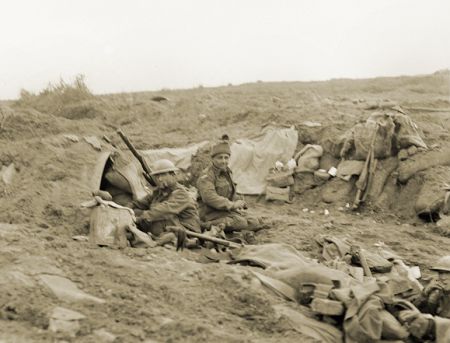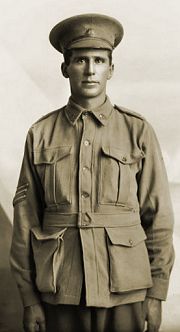Melbourne Tram Museum
- Follow Melbourne Tram Museum on Twitter
- Follow Melbourne Tram Museum on Facebook
- Follow Melbourne Tram Museum on Instagram
- Follow Melbourne Tram Museum on Pinterest
- Follow Melbourne Tram Museum on Tumblr
- Subscribe to Melbourne Tram Museum's RSS feed
- Email Melbourne Tram Museum
Tramway ANZAC: Charles Henry Haar
From Gallipoli to the Western Front
When he first enlisted in January 1915, just over five months after the declaration of war in August 1914, Charles Henry “Charlie” Haar was a 32 year old labourer.
Originally from Nhill, Charlie was married with two daughters and three stepchildren. At that time, many tramway employees came from rural areas – a series of economic depressions and recessions from the 1890s until 1914 saw many rural workers shifting to Melbourne in search of employment opportunities. Indeed the first decade of the twentieth century marked the beginning of migration from the country to the city – a process that still continues.
Unlike many with German-sounding names, there is no evidence of any discrimination within Charlie’s service record. Second-generation Australians, the family regarded themselves as proud and loyal citizens. Charlie embarked from Melbourne on 13 April 1915, joining the 7th Battalion on 22 May 1915 and was posted to C Company on 26 May 1915.
7th Battalion had taken part in the ANZAC landing at Gallipoli on 25 April 1915 and then in the attack on Cape Helles where casualties had been severe. Charlie was a member of the reinforcements sent for the battalion. He had been promoted to Corporal but for some unspecified reason this appointment was cancelled in June 1915.
Less than two months after arriving at Gallipoli he became ill and was sent via hospital ship to Alexandria and then in August 1915 was admitted to hospital in Cairo. This illness proved to be severe enough for him to be returned to Melbourne where he obtained a medical discharge in November 1915.

No 2 Australian General Hospital, AIF, Mena, Egypt, January 1915. Charlie Haar was evacuated here from Gallipoli before he was sent back to Melbourne.- Photograph courtesy Australian War Memorial (H12179).
Upon discharge, Charlie joined the Melbourne Tramway & Omnibus Company (MTOC) where he was employed as a casual gripman on the Brighton Road line. He was only with MTOC for a few months before he re-enlisted on 3 May 1916. It was not unusual for new gripmen to be involved in various incidents, and in his first two months Charlie was no exception. Only a week after starting, a girl was knocked down by his tram, however it was determined that Charlie was not to blame. Later that same day he neglected to release the cable when passing the St Kilda Road engine house, which resulted in the cable being pulled out and the grip damaged. His employment record notes that at that time he had been preoccupied with the accident earlier that day. Three weeks later he knocked a man down, but again was held not to blame. His final incident was a few days later when he ran his tram into the back of the preceding tram and was cautioned. There were no further incidents recorded for his remaining five months with MTOC.
Charlie embarked from Melbourne on 25 September 1916, attached to the 15th Reinforcements, 22nd Battalion. He arrived in England on 10 November 1916 and was sent to France on 14 December 1916. He was taken on strength in 22 Battalion on 23 December 1916 and was promoted to Lance Corporal on 9 June 1917.
The Third Battle of Ypres spanned the period July to November 1917. The original aim of the British command was to penetrate heavily-fortified German-held territory to the south and east of the Belgian city of Ypres and eventually progress through to the German submarine bases on the Belgian coast. However the individual offensives proved to be extremely costly for limited gain. By August it became apparent that the original objective would not be realised, nonetheless the commander of the British forces, Field Marshall Douglas Haig, maintained the offensives, aiming to weaken the German forces through attrition despite the huge casualties incurred by the Allied forces.
The offensive of 4 October 1917, known as the Battle of Broodseinde Ridge, involved twelve divisions, including the First, Second and Third Australian Divisions and the New Zealand Division. As in the previous offensives of the Third Battle of Ypres, a massive artillery bombardment preceded the advance of the troops, who were to achieve and consolidate defined positions. The Australian Second Division (which included 22 Battalion) was required to advance around 1500 metres. However the opposing German forces also chose the same day to mount an attack.
 Sheltering at Broodseinde Ridge during the fighting on 4 October 1917.
Sheltering at Broodseinde Ridge during the fighting on 4 October 1917.
- Photograph courtesy Australian War Memorial (E01051).
At 4:10am 22 Battalion was in position, preparing to attack. At 5:35am the Germans commenced a heavy bombardment.
At around 6am Charlie Haar was leading a section to the attack when a shell landed close to him. As he did not return from the attack, he was reported missing. In the subsequent inquiry into his fate witnesses described his death as instantaneous, burial site unknown.
It was estimated that one-seventh of the Australian attacking force were killed or wounded in that bombardment. Australian casualties on that single day totalled nearly 6500.
With no known grave, Charlie Haar is commemorated on the Menin Gate Memorial in Ypres, Belgium. This is one of four memorials to the missing of the Flanders conflict. The Menin Gate records the names of more than 54,000 British and Commonwealth officers and soldiers, including 6000 Australians.
Acknowledgements
Many thanks to Warren Doubleday and Matt Haar for their assistance and advice.
Bibliography
The Age (1918), Deaths On Active Service, 29 May 1918
Australian Imperial Force Unit War Diaries (1914-1918), 22nd Infantry Battalion, October 1917
Australian Red Cross Society (1914-1918), Wounded and Missing Enquiry Bureau Files – 5611 Lance Corporal Charles Henry Haar, 22nd Battalion
Australian War Memorial, 7th Australian Infantry Battalion
Australian War Memorial, Battle of Broodseinde Ridge
National Archives of Australia (1914-1918), Charles Henry Haar – Service Record
National Archives of Australia (1914-1918), Henry Haar – Service Record
Public Record Office Victoria (1899-1924), Tramways Employees Record Book, VPRS 12738/P0002
John F. Williams (2003), German ANZACs and the First World War, UNSW Press.
